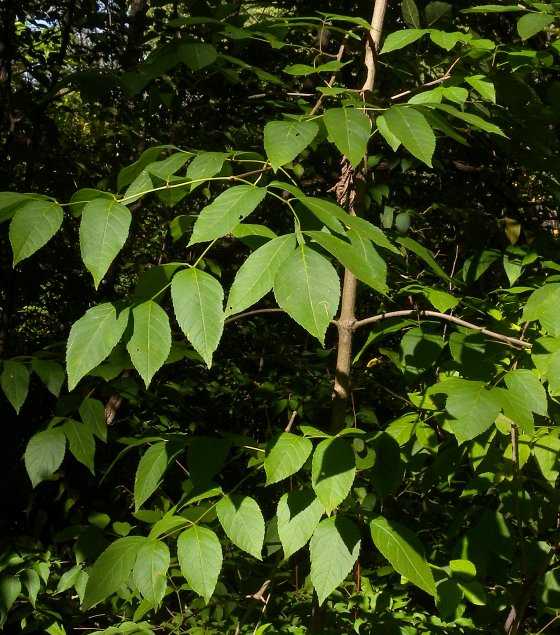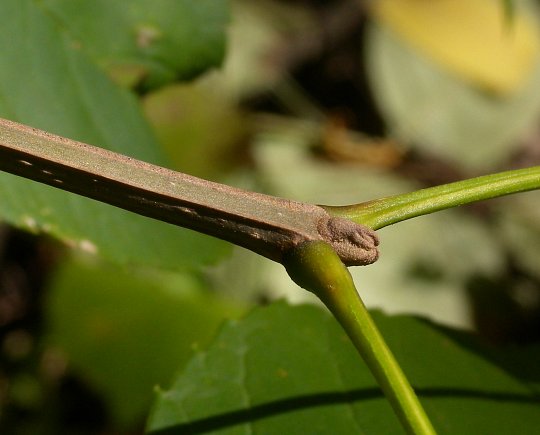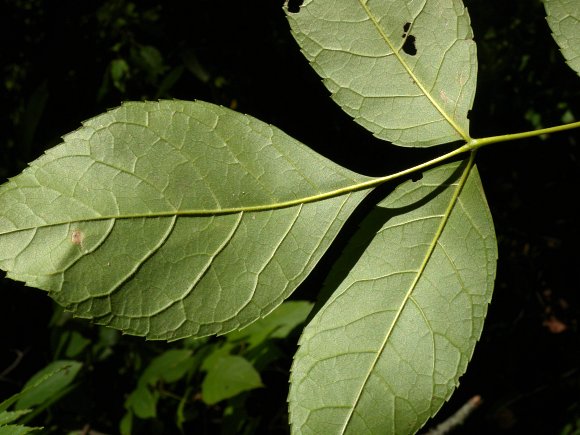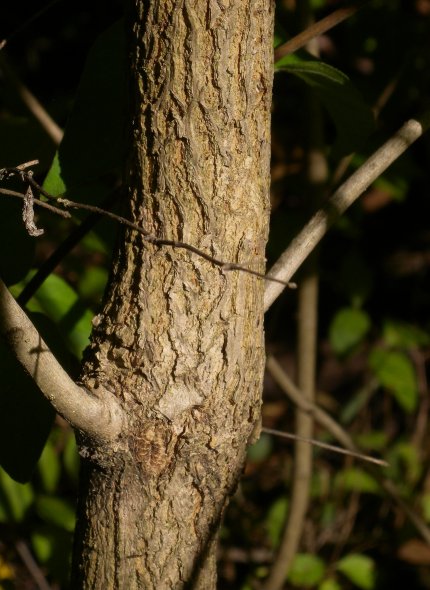Blue Ash
Fraxinus quadrangulata
Olive family (Oleaceae)
Fraxinus quadrangulata
Olive family (Oleaceae)
Description:
This is a medium-large, single-trunked tree with a narrow irregular
crown that is 50–80' tall at maturity. The trunk of a mature tree is
1½–3' across and its bark is medium gray and coarsely scaly with short
irregular ridges that are flat-topped and separated by shallow
irregular furrows.
The trunk bark of less mature trees and saplings tend to be less
coarsely scaly and more brown. The larger lateral branches are widely
spreading, except toward the bottom of the crown, where they have a
tendency to droop, and toward the top of the crown, where they are more
ascending. The smaller branches and twigs tend to be short and somewhat
crooked and irregular overall. Young twigs are sharply 4-angled and
they sometimes have narrow short wings at the angles; their bark is
light gray to light brown and rather smooth with scattered white
lenticels (air pores). Terminal buds are rather short, ovoid in shape,
hairy, and brown. The petiole-scars on the twigs are very convex below
and slightly concave above. Pairs of opposite leaves occur at intervals
along the twigs and young shoots. These opposite leaves are odd-pinnate
with 5–11 leaflets (usually they have 7–9 leaflets). Individual
leaflets are 2–4½" long and ¾–2" across; they are lanceolate to
lanceolate-ovate in shape with serrated margins. The upper leaflet
surface is yellowish green to medium green and hairless, while the
lower leaflet surface is pale green and mostly hairless, except along
the primary veins, where it is finely short-pubescent. The leaflets
have short petiolules (basal stalklets) about 2–6 mm. long. The
petioles, central rachis (central stalk of the odd-pinnate leaf), and
petiolules are all light green and hairless.

The small flowers of this tree develop from the axils of last year's leaves near the tips of twigs, occurring in tight clusters. These flowers are usually perfect (with both male and female sex organs); less often they are single-sexed. Individual perfect flowers consist of an ovary with a style with a bifurcated tip, 2 stamens (rarely more), no petals, and either a green insignificant calyx or none. The flowers are light green to purple. The blooming period occurs during mid-spring, lasting about 2 weeks. Cross-pollination is by wind. Afterwards, clusters of fertile flowers with female sex organs develop into raceme-like panicles of samaras spanning up to 6" long, while the remaining clusters of flowers drop off the tree without further development. Individual samaras are 1–1½" long, ¼–½" across, and elliptic-oblanceolate to oblong-oblanceolate in shape. The winged section of the typical samara is flat and either rounded or shallowly notched at its tip; it extends along both sides of the seed body to nearly the base. The seed body extends to about one-half of the length of the samara; it is slightly swollen, but noticeably flattened. Immature samaras are light green and hairless, while mature samaras turn tan or brown during autumn. Mature samaras eventually fall off the tree, when they are distributed to some extent by the wind. This tree reproduces by reseeding itself.

Cultivation: The preference is full or partial sun, mesic to dry-mesic conditions, and slightly acidic to alkaline soil containing calcium and other minerals. This soil can contain loam, clay-loam, or some rocky material. This tree is drought tolerant, but dislikes flooded conditions. It is hardy to Zone 4. Healthy specimens of this tree can live 100–150 years.
Range & Habitat: The native Blue Ash (Fraxinus quadrangulata) is uncommon to occasional in most areas of Illinois, except the southeast section of the state, where it is absent in the wild (see Distribution Map). While this tree is not currently listed as endangered within the state, its population will probably decline because of an introduced insect pest, the Emerald Ash Borer (Agrilus planipennis). However, Blue Ash appears to be more resistant to this insect pest than other native ash species (Fraxinus spp.); see Tanis & McCullough (2012) and Peterson et al. (2015) for further discussions. Blue Ash occurs primarily in east-central USA in Missouri, Illinois, Indiana, Ohio, Kentucky, and Tennessee. Habitats include upland deciduous woodlands, wooded slopes, thinly wooded bluffs, edges of limestone glades, and areas along limestone cliffs. Wooded areas with limestone as the underlying bedrock are preferred, although it also occurs in wooded areas growing on glacial till, especially well-drained moraines. Blue Ash is typically found in average to high quality woodlands in natural areas. It is uncommonly cultivated.

Faunal Associations: Insects that feed on the leaves, wood, and other parts of ash trees (Fraxinus spp.) include leaf beetles, larvae of long-horned beetles, larvae of weevils, larvae of bark beetles, larvae of gall flies, plant bugs, woolly aphids, armored scales, larvae of sawflies, and larvae of many moths (see Insect Table and Moth Table). The carnivorous larvae of a butterfly, Feniseca tarquinius (Harvester), feed on the woolly aphids that are found on ash trees and other trees. The leaves of ash trees are host plants of the polyphagous larvae of a butterfly, Papilio glaucus (Tiger Swallowtail); see Bouseman & Sternburg (2001). Birds that feed on the seeds of ash trees include the Wood Duck, Northern Cardinal, Evening Grosbeak, Purple Finch, Redwing Blackbird, Bobwhite Quail, and Wild Turkey. The Yellow-bellied Sapsucker sometimes drills holes through the bark of young ash trees to feed on their sap. Ash trees are a source of food to some mammals too. For example, the Fox Squirrel and White-footed Mouse eat the seeds of these trees, while White-tailed Deer feed on their twigs during the winter (Martin et al., 1951/1961; DeGraaf (2002).
Photographic Location: An upland wooded area high above a river in Busey Woods, Urbana, Illinois. The photographed tree is a young sapling about 15' tall.

Comments: Blue Ash is an easy tree to identify because of its sharply 4-angled twigs that are sometimes short-winged along their angles. The width of its leaflets are somewhat variable: there is an unnamed form of this tree with more narrow leaflets that taper gradually into elongated tips, and another unnamed form of this tree with more broad leaflets that taper less gradually toward their tips. All other ash trees (Fraxinus spp.) in Illinois have terete twigs that are circular in cross-section. Unlike Green Ash (Fraxinus pennsylvanica lanceolata), Red Ash (Fraxinus pennsylvanica pennsylvanica), and White Ash (Fraxinus americana), Blue Ash has a more scaly trunk bark that doesn't produce the interwoven distinct ridges and furrows of the preceding ash trees; in this regard, it is more similar to Black Ash (Fraxinus nigra). Blue Ash is also unusual because it often produces perfect flowers, rather than dioecious flowers. As a result, it is more likely to cross-pollinate its flowers and produce samaras than other species in its genus. Ash trees can be distinguished from other common trees with pinnate leaves by the opposite arrangement of their pinnate leaves along twigs and young shoots; hickories (Carya spp.), Black Walnut (Juglans nigra), and the Tree-of-Heaven (Ailanthus altissima) have alternate pinnate leaves. When the leaflets of ash trees are crushed, they do not exude a strong fragrance, unlike the leaflets of Black Walnut, Tree-of-Heaven, and some hickories.

The small flowers of this tree develop from the axils of last year's leaves near the tips of twigs, occurring in tight clusters. These flowers are usually perfect (with both male and female sex organs); less often they are single-sexed. Individual perfect flowers consist of an ovary with a style with a bifurcated tip, 2 stamens (rarely more), no petals, and either a green insignificant calyx or none. The flowers are light green to purple. The blooming period occurs during mid-spring, lasting about 2 weeks. Cross-pollination is by wind. Afterwards, clusters of fertile flowers with female sex organs develop into raceme-like panicles of samaras spanning up to 6" long, while the remaining clusters of flowers drop off the tree without further development. Individual samaras are 1–1½" long, ¼–½" across, and elliptic-oblanceolate to oblong-oblanceolate in shape. The winged section of the typical samara is flat and either rounded or shallowly notched at its tip; it extends along both sides of the seed body to nearly the base. The seed body extends to about one-half of the length of the samara; it is slightly swollen, but noticeably flattened. Immature samaras are light green and hairless, while mature samaras turn tan or brown during autumn. Mature samaras eventually fall off the tree, when they are distributed to some extent by the wind. This tree reproduces by reseeding itself.

Cultivation: The preference is full or partial sun, mesic to dry-mesic conditions, and slightly acidic to alkaline soil containing calcium and other minerals. This soil can contain loam, clay-loam, or some rocky material. This tree is drought tolerant, but dislikes flooded conditions. It is hardy to Zone 4. Healthy specimens of this tree can live 100–150 years.
Range & Habitat: The native Blue Ash (Fraxinus quadrangulata) is uncommon to occasional in most areas of Illinois, except the southeast section of the state, where it is absent in the wild (see Distribution Map). While this tree is not currently listed as endangered within the state, its population will probably decline because of an introduced insect pest, the Emerald Ash Borer (Agrilus planipennis). However, Blue Ash appears to be more resistant to this insect pest than other native ash species (Fraxinus spp.); see Tanis & McCullough (2012) and Peterson et al. (2015) for further discussions. Blue Ash occurs primarily in east-central USA in Missouri, Illinois, Indiana, Ohio, Kentucky, and Tennessee. Habitats include upland deciduous woodlands, wooded slopes, thinly wooded bluffs, edges of limestone glades, and areas along limestone cliffs. Wooded areas with limestone as the underlying bedrock are preferred, although it also occurs in wooded areas growing on glacial till, especially well-drained moraines. Blue Ash is typically found in average to high quality woodlands in natural areas. It is uncommonly cultivated.

Faunal Associations: Insects that feed on the leaves, wood, and other parts of ash trees (Fraxinus spp.) include leaf beetles, larvae of long-horned beetles, larvae of weevils, larvae of bark beetles, larvae of gall flies, plant bugs, woolly aphids, armored scales, larvae of sawflies, and larvae of many moths (see Insect Table and Moth Table). The carnivorous larvae of a butterfly, Feniseca tarquinius (Harvester), feed on the woolly aphids that are found on ash trees and other trees. The leaves of ash trees are host plants of the polyphagous larvae of a butterfly, Papilio glaucus (Tiger Swallowtail); see Bouseman & Sternburg (2001). Birds that feed on the seeds of ash trees include the Wood Duck, Northern Cardinal, Evening Grosbeak, Purple Finch, Redwing Blackbird, Bobwhite Quail, and Wild Turkey. The Yellow-bellied Sapsucker sometimes drills holes through the bark of young ash trees to feed on their sap. Ash trees are a source of food to some mammals too. For example, the Fox Squirrel and White-footed Mouse eat the seeds of these trees, while White-tailed Deer feed on their twigs during the winter (Martin et al., 1951/1961; DeGraaf (2002).
Photographic Location: An upland wooded area high above a river in Busey Woods, Urbana, Illinois. The photographed tree is a young sapling about 15' tall.

Comments: Blue Ash is an easy tree to identify because of its sharply 4-angled twigs that are sometimes short-winged along their angles. The width of its leaflets are somewhat variable: there is an unnamed form of this tree with more narrow leaflets that taper gradually into elongated tips, and another unnamed form of this tree with more broad leaflets that taper less gradually toward their tips. All other ash trees (Fraxinus spp.) in Illinois have terete twigs that are circular in cross-section. Unlike Green Ash (Fraxinus pennsylvanica lanceolata), Red Ash (Fraxinus pennsylvanica pennsylvanica), and White Ash (Fraxinus americana), Blue Ash has a more scaly trunk bark that doesn't produce the interwoven distinct ridges and furrows of the preceding ash trees; in this regard, it is more similar to Black Ash (Fraxinus nigra). Blue Ash is also unusual because it often produces perfect flowers, rather than dioecious flowers. As a result, it is more likely to cross-pollinate its flowers and produce samaras than other species in its genus. Ash trees can be distinguished from other common trees with pinnate leaves by the opposite arrangement of their pinnate leaves along twigs and young shoots; hickories (Carya spp.), Black Walnut (Juglans nigra), and the Tree-of-Heaven (Ailanthus altissima) have alternate pinnate leaves. When the leaflets of ash trees are crushed, they do not exude a strong fragrance, unlike the leaflets of Black Walnut, Tree-of-Heaven, and some hickories.